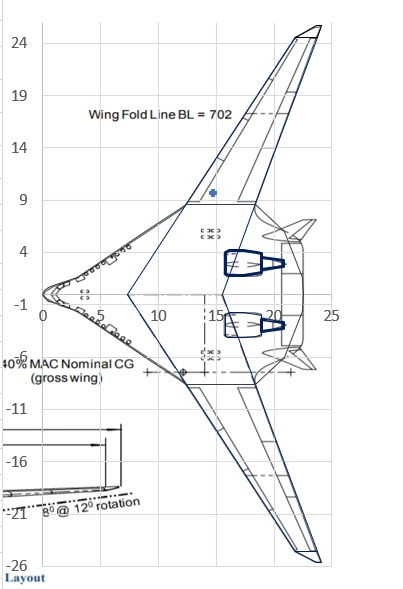RAWAvCon - Hybrid Wing Body Aircraft

Image: NASA/Boeing
I have extended RAWAvCon's capability to include analysis of Blended or Hybrid Wing Body aircraft configuration. The first important step has been to model the geometry of the centre body and how this interacts with the wing as well as a canted twin-fin.

The 3 view images in this article are taken directly from RAWAvCon. The Dark Blue thick lines are the plotted RAWAvCon geometry for the Boeing Sugar Ray Configuration from the 2011 NASA/Boeing CR–2011-216847 document reporting these studies - these are plotted over images from that NASA/Boeing document to aid the geometry definition (the detail on the fuselage, wing and the engine fan, plus dimensions).

At this point, the drag methods (including S&C) and centre body mass methods are relatively simple based on trends the limited data available in the public domain for such aircraft. Many of the other drag, mass and propulsion methods are common with the conventional configurations - which is why I like the 'less-conventional' term rather than 'unconventional'.

The 1st principle flight performance is also common using the revised drag polar, engine model and weight forecasts.
This will provide a baseline to further improve this modelling capability as the results of more design work and research projects are published. I also intend to integrate this new less conventional capability with previously developed methods to model hybrid-electric and full-electric propulsion systems, although this is still currently in at the prototype stage.
Given that the NASA/Boeing Document defines component weights and aerodynamic drag polars, I can calibrate the RAWAvCon methods to provide representative performance results.
I also intend to model additional BWB/HWB concepts ranging from business jets, the NASA ERA concepts as well as the larger 777 class Lockheed HWB concepts to generate further calibration points for the modelling capability.
I also intend to add some automated definition to show where the body is deep enough for a full passenger cabin, seated passengers only as well as freight holds (probably in the wing-body blend) as packaging is an important issue for such aircraft.
Please get in touch through this website or by email if you would like to discuss how this capability can be of use to your organisation.



















